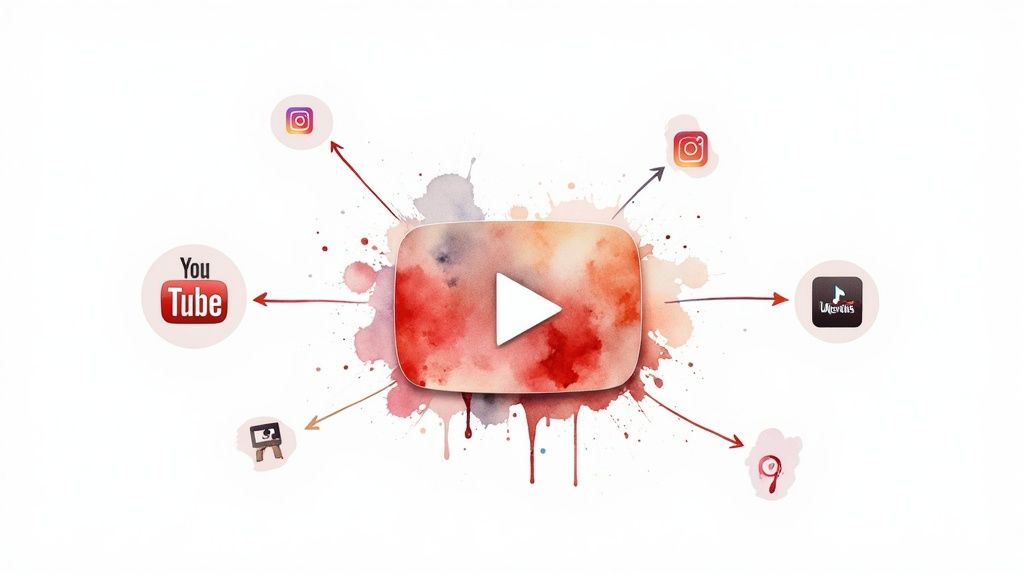10 High-Impact Content Distribution Strategies for 2025

Creating exceptional content is only half the battle. Without a robust plan to deliver it to the right audience, even the most brilliant work can fail to make an impact. The digital landscape is more crowded than ever, and simply hitting 'publish' is no longer enough. The "if you build it, they will come" approach is a myth. Effective content distribution is the critical engine that drives visibility, engagement, and return on investment.
This guide moves beyond generic advice to provide a detailed roadmap of 10 powerful content distribution strategies. We will explore how to leverage a multi-channel approach to amplify your message, maximize reach, and turn your content into a consistent engine for growth. Whether you're a solopreneur, a marketing agency, or a personal brand, understanding these frameworks is essential for getting your work seen by the people who matter most.
Inside, you will find a complete playbook covering everything from social media and email marketing to advanced tactics like content syndication and building a dedicated content hub. Each strategy is broken down into actionable steps, real-world examples, and expert tips, empowering you to build a distribution framework that works as hard as your content does.
1. Social Media Content Distribution
Social media content distribution is the strategic practice of sharing your content across various social platforms to maximize its reach, engagement, and impact. It goes beyond simply auto-posting the same link everywhere. This approach involves tailoring your message, format, and timing to the unique audience and features of each platform, from Instagram's visual-first feed to LinkedIn's professional network. By adapting content to fit platform culture, you transform a single asset into multiple, highly-relevant touchpoints.

Consider how Wendy's uses Twitter for witty, viral roasts, while Red Bull leverages Instagram and YouTube for high-octane extreme sports videos. Both are powerful examples of aligning content with platform expectations. This is a fundamental element of modern content distribution strategies because it allows you to meet your audience where they are most active.
How to Implement This Strategy
- Adapt, Don't Just Syndicate: Repurpose your core content into platform-native formats. Turn a blog post into a Twitter thread, an infographic for Pinterest, a short video for TikTok, and a discussion-starter for LinkedIn.
- Leverage Native Features: Actively use features like Instagram Stories, Twitter Spaces, and LinkedIn Articles. Platforms often reward the use of their newest tools with increased visibility.
- Engage Authentically: Distribution isn't just about posting; it's about starting conversations. Respond to comments, participate in relevant discussions, and acknowledge user-generated content to build a community.
When to Use This Approach
This strategy is essential for any brand aiming to build community, increase brand awareness, and drive traffic directly from social channels. It is particularly effective for B2C brands, personal brands, and media companies whose content is designed for broad consumption. For those looking to turn social interactions into measurable business results, you can explore more on social media lead generation strategies.
2. Email Marketing and Newsletter Distribution
Email marketing is a powerful, direct content distribution strategy that involves sending curated content, updates, and promotional materials to a list of subscribers. Unlike social media, where algorithms dictate reach, email provides a direct and owned communication channel to your audience. This method focuses on building a personal relationship over time by consistently delivering value directly to the inbox, turning a passive audience into a loyal, engaged community.

Newsletters like Morning Brew and The Hustle exemplify this by delivering engaging news summaries to millions, creating a daily habit for their readers. Similarly, creators on platforms like ConvertKit use email to share exclusive content and build a business around their expertise. This approach is a cornerstone of effective content distribution strategies because it creates a direct, reliable line of communication that you completely control.
How to Implement This Strategy
- Prioritize Value Over Promotion: Ensure every email provides genuine value, whether it's an insight, a useful resource, or a compelling story. A sales pitch should be secondary to the content.
- Segment Your Audience: Group subscribers based on their interests, past behaviors, or how they signed up. This allows you to send highly relevant content that resonates better and drives more engagement.
- Optimize for Open Rates: Craft compelling, clear, and intriguing subject lines. A/B test different formats, lengths, and the use of personalization to see what your audience responds to.
- Automate Smartly: Use automation for welcome sequences to onboard new subscribers and for nurture campaigns to guide them through your content funnel based on their actions.
When to Use This Approach
This strategy is vital for any business or creator aiming to build long-term relationships, nurture leads, and drive repeat engagement. It is particularly effective for B2B companies, e-commerce stores, and subject matter experts who want to establish authority and trust. For those seeking to turn their audience into a sustainable business, this owned channel is non-negotiable. Ann Handley’s work showcases how powerful storytelling can transform a standard newsletter into a must-read experience.
3. Content Syndication Networks
Content syndication is a powerful content distribution strategy where you republish your original content on third-party websites. Instead of waiting for an audience to find you, this method lets you tap into the established readership of larger platforms like industry publications, content aggregators, and publishing networks. It's a way to significantly amplify your message, placing your expertise in front of new, highly relevant audiences and driving qualified traffic back to your site.
For example, a B2B SaaS company might republish a detailed case study on LinkedIn's publishing platform to reach professional decision-makers. Similarly, a writer can post their work on Medium to connect with a community of avid readers. These content distribution strategies work because they leverage the authority and existing audience of the host platform, giving your content an immediate visibility boost.
How to Implement This Strategy
- Prioritize SEO with Canonical Tags: When you republish content, use a canonical tag (
rel="canonical") pointing back to the original article on your website. This tells search engines which version is the primary one, preventing duplicate content penalties and consolidating SEO authority. - Build Relationships with Editors: Don't just cold-pitch publications. Engage with editors and content managers on social media and build a genuine rapport before you ask them to syndicate your work. This greatly increases your chances of success.
- Tailor Content for Each Platform: Lightly edit your article's title, introduction, or conclusion to better fit the tone and audience of the syndication partner. A more formal tone might suit an industry journal, while a conversational style works for Medium.
When to Use This Approach
This strategy is ideal for brands focused on building authority, generating high-quality backlinks, and driving referral traffic. It is especially effective for B2B marketers, thought leaders, and any creator looking to expand their reach beyond their owned channels. If your goal is to quickly establish credibility in a new niche, syndication offers a direct path to a pre-built, engaged audience. It’s also a key tactic in many advanced SaaS marketing strategies.
4. Search Engine Optimization (SEO) Distribution
Search Engine Optimization (SEO) is a long-term content distribution strategy focused on creating and optimizing content to rank highly in search engine results. Unlike paid or social promotion that provides a temporary traffic boost, SEO distribution is an organic approach that consistently attracts an audience actively searching for the information, products, or services you offer. It positions your content as a valuable, authoritative answer to a user's query directly within platforms like Google.
Look at how HubSpot’s blog dominates search results for marketing-related terms or how Brian Dean’s Backlinko ranks for highly competitive SEO keywords. They don't just write content; they engineer it to meet search engine criteria and user intent. This makes SEO one of the most powerful and sustainable content distribution strategies because it turns search engines into an automated delivery channel for highly qualified traffic.
How to Implement This Strategy
- Focus on Search Intent: Go beyond basic keywords. Understand whether a user is looking for information (what is…), a specific website (HubSpot), a transaction (buy…), or an investigation (best…).
- Build Topic Clusters: Create a central "pillar" page for a broad topic and surround it with "cluster" content covering related subtopics. This signals your expertise to search engines.
- Optimize for Modern SERPs: Aim for more than just the #1 spot. Optimize for featured snippets, "People Also Ask" boxes, and voice search queries by providing direct, concise answers.
- Prioritize Technical Health: Ensure your website has fast page speeds, is mobile-friendly, and has a clean structure. Technical issues can prevent even the best content from ranking.
When to Use This Approach
This strategy is foundational for any business that relies on organic discovery to generate leads, sales, or authority. It is especially critical for B2B companies, service providers, and niche e-commerce stores whose customers begin their buying journey with a search query. If your goal is to build a durable asset that generates compounding traffic and leads over time, SEO is a non-negotiable part of your distribution plan.
5. Influencer and Partner Collaborations
Influencer and partner collaborations involve leveraging the authority and reach of established individuals or brands to distribute your content. This strategy taps into pre-built, trusting communities, allowing your message to be delivered through a voice the audience already respects. Instead of broadcasting to a cold audience, you are getting a warm introduction from a credible source, making this one of the most effective content distribution strategies for building brand affinity and trust at scale.
This method moves beyond simple paid shout-outs. True collaboration means co-creating value, where the influencer or partner is genuinely invested in the content's success. Think of Gymshark, which built its empire by creating a community of fitness influencers who live and breathe the brand, or Adobe’s Creative Residency, which empowers creators who in turn showcase the power of Adobe's tools authentically. This approach amplifies reach and lends third-party validation to your content.
How to Implement This Strategy
- Prioritize Authentic Alignment: Focus on partners whose audience and values genuinely overlap with yours. A smaller, highly-engaged audience is often more valuable than a massive, irrelevant one.
- Develop Long-Term Relationships: Shift from one-off transactional campaigns to ongoing partnerships. This builds deeper authenticity and allows influencers to become true brand ambassadors.
- Co-Create and Empower: Involve partners in the content creation process. Give them creative freedom within clear brand guidelines to ensure the final product feels native to their channel and resonates with their audience.
- Establish Clear Expectations: Use formal agreements or contracts to outline deliverables, usage rights for influencer-generated content, compensation, and key performance indicators (KPIs) to ensure both parties are aligned.
When to Use This Approach
This strategy is exceptionally powerful for brands in visually-driven or community-centric niches like beauty (Glossier), fitness (Gymshark), and tech (Adobe). It is ideal for launching new products, entering new markets, or building deep credibility with a specific demographic. Use this approach when your goal is not just to gain visibility but to earn the trust and loyalty of a highly targeted audience through authentic endorsements. For those focusing on this, it's worth exploring the nuances of building a brand ambassador program to formalize these relationships.
6. Paid Advertising and Promotion
Paid advertising is a performance-driven content distribution strategy that leverages paid channels to guarantee immediate visibility. By utilizing platforms like Google Ads, Facebook Ads, and LinkedIn Ads, you can place your content directly in front of highly specific, targeted audiences. Unlike organic methods that build momentum over time, paid promotion offers controlled, scalable reach and provides precise, measurable results, allowing you to track ROI from the very first click.
Consider how Dollar Shave Club’s viral video ad became a cultural phenomenon or how Purple Mattress used quirky, educational video ads on Facebook to dominate the online mattress space. Both are prime examples of using paid channels not just for sales but for amplifying brand-building content. This makes paid promotion one of the most powerful and predictable content distribution strategies available for achieving rapid growth and market penetration.
How to Implement This Strategy
- Start Small and Scale: Begin with a modest budget to test different campaigns. Identify what works best, then reallocate your spending to scale the high-performing ads and maximize your return.
- Focus on High-Impact Creative: In a paid environment, your content must stop the scroll. Invest in high-quality visuals, compelling headlines, and clear calls-to-action that capture attention instantly.
- Utilize Retargeting: A crucial tactic is to run retargeting campaigns that show specific content to users who have already interacted with your brand. This nurtures interest and guides them further down the funnel.
When to Use This Approach
This strategy is ideal when you need immediate results, want to reach a very specific demographic, or are promoting high-value content like a webinar, whitepaper, or product launch. It is essential for B2B marketers using LinkedIn for lead generation and for e-commerce brands needing to drive direct sales. If your goal is to generate predictable traffic and leads with a measurable ROI, paid promotion is indispensable.
7. Video Content Distribution
Video content distribution is a multimedia-first strategy that leverages the high engagement and memorability of video across diverse platforms. This approach prioritizes creating and sharing video content on channels like YouTube, TikTok, Instagram Reels, and LinkedIn Video. As audience preference shifts dramatically towards visual consumption, integrating video is no longer optional but a core component of effective content distribution strategies. It captures attention faster and conveys complex information more effectively than text alone.

Think of how Tasty's overhead recipe videos went viral on Facebook, or how TED Talks built a global brand by distributing educational speeches on YouTube. These examples showcase the power of tailoring video to a platform's format and audience expectations. This strategy capitalizes on the fact that platforms are heavily prioritizing video, often rewarding such content with greater algorithmic reach.
How to Implement This Strategy
- Hook Viewers Instantly: The first three seconds are critical. Start with a compelling question, a surprising visual, or a bold statement to prevent users from scrolling past.
- Optimize for Each Platform: Create platform-specific formats. A 10-minute deep dive for YouTube can be repurposed into a 60-second Reel for Instagram, a vertical short for TikTok, and a professional tip for LinkedIn.
- Prioritize Accessibility and Mobile: Most video is consumed on mobile devices, often without sound. Always add captions or subtitles and ensure your video is vertically formatted or looks great on a small screen.
When to Use This Approach
This strategy is vital for any brand aiming to maximize engagement, explain complex products or services, and build a strong human connection with their audience. It's particularly powerful for B2C brands, educators, personal brands, and any business where visual demonstration enhances value. If you're looking to build authority and community on platforms that are increasingly video-centric, this is a non-negotiable approach.
8. Community Building and Forums
Community building is a relationship-first distribution strategy focused on creating and nurturing dedicated spaces for people with shared interests. This involves using platforms like Discord, Reddit, or Facebook Groups to foster a sense of belonging around your brand, industry, or values. Instead of broadcasting content, this approach cultivates an environment where members can connect, share, and engage with each other, positioning your brand as the central hub of a valuable network.

Think of successful examples like the Indie Hackers forum for entrepreneurs or Peloton's vibrant Facebook Groups where users share workout milestones. These communities thrive because the brand provides a platform for genuine connection, not just a channel for promotion. This is one of the most powerful long-term content distribution strategies because it builds a loyal, self-sustaining audience that trusts your brand implicitly.
How to Implement This Strategy
- Provide Value First: Share exclusive content, host Q&A sessions, and facilitate discussions that help members without asking for anything in return. Build trust before introducing promotional content.
- Encourage Member-to-Member Interaction: Create prompts, daily discussion threads, and member spotlights to encourage users to talk to each other, not just to your brand.
- Establish Clear Guidelines: Create and enforce a clear set of rules for participation to ensure the community remains a safe, positive, and productive space for everyone.
- Recognize Top Contributors: Publicly acknowledge and reward your most active and helpful members to encourage continued participation and set a positive example.
When to Use This Approach
This strategy is ideal for niche brands or those in industries with highly passionate audiences, such as tech, gaming, fitness, or entrepreneurship. It is incredibly effective for fostering long-term loyalty, gathering direct product feedback, and reducing reliance on traditional advertising. To master the art of nurturing these online spaces, you can explore more on social media community management.
9. Podcast and Audio Content Distribution
Podcast and audio content distribution is a strategy centered on creating and sharing audio-first media to reach audiences in screen-free moments. This intimate format leverages platforms like Spotify, Apple Podcasts, and Google Podcasts to connect with listeners during commutes, workouts, or daily chores. By delivering value through voice, you can build a deeply loyal audience and establish authority in your niche, making it one of the most personal content distribution strategies available.
Look at how The Tim Ferriss Show uses long-form interviews with world-class performers to deliver in-depth insights, or how Marketing School provides daily, bite-sized tips. Both have built massive followings by mastering the audio medium. This approach is powerful because audio fosters a one-on-one connection that is difficult to replicate with text or even video, creating a strong sense of community and trust.
How to Implement This Strategy
- Prioritize Audio Quality: Invest in a good microphone and editing software. Poor audio quality is one of the quickest ways to lose a listener's attention.
- Establish a Consistent Schedule: Whether it's daily, weekly, or bi-weekly, a reliable publishing cadence helps build listener habits and anticipation.
- Cross-Promote with Guests: When you feature a guest, leverage their network by coordinating promotional efforts. This exposes your show to a new, relevant audience.
- Repurpose Audio into Other Formats: Transcribe episodes into blog posts, pull key quotes for social media graphics, and create short video clips (audiograms) to promote on other channels.
When to Use This Approach
This strategy is ideal for brands and creators who want to build deep, long-term relationships and establish themselves as thought leaders. It's particularly effective for B2B marketers, coaches, experts, and anyone aiming to share complex ideas in an easily digestible format. If you can commit to consistency and providing genuine value, podcasting offers a direct line to a highly engaged audience. For more on expanding your show, consider exploring podcast marketing tactics.
10. Content Hub and Owned Media Strategy
A content hub and owned media strategy is a centralized approach where you build and maintain your own digital properties, like a blog or resource center, as the primary distribution channel. This method puts you in complete control of the user experience, brand narrative, and audience data, freeing you from the unpredictable algorithms and policies of third-party platforms. It's about turning your website into a destination, not just a digital brochure.
Look at how HubSpot has built an empire on its comprehensive marketing blog and resource hub, or how Salesforce's Trailhead platform became the go-to learning center for its ecosystem. These brands invested in their owned media to create a powerful, direct line to their audience. This is one of the most sustainable content distribution strategies because it builds a long-term asset that appreciates in value over time.
How to Implement This Strategy
- Create Topic Clusters: Organize your content around core pillar pages linked to related sub-topics. This structure builds topical authority and significantly boosts SEO performance.
- Integrate Email Capture: Strategically place newsletter sign-up forms, content upgrade offers, and gated premium resources to convert visitors into subscribers, building a direct communication channel.
- Optimize for Experience: Ensure your hub has fast loading speeds, is mobile-responsive, and uses strong internal linking to guide users deeper into your content and keep them on-site longer.
When to Use This Approach
This strategy is foundational for any business focused on long-term growth, lead generation, and building brand authority. It is particularly crucial for B2B companies, SaaS businesses, and any organization with a complex sales cycle where educating the consumer is key. If your goal is to own your audience relationship rather than rent it from social platforms, this approach is non-negotiable.
Content Distribution Strategies Comparison
| Distribution Strategy | Implementation Complexity 🔄 | Resource Requirements ⚡ | Expected Outcomes 📊 | Ideal Use Cases 💡 | Key Advantages ⭐ |
|---|---|---|---|---|---|
| Social Media Content Distribution | Medium to High – requires multi-platform management and constant content creation | Medium – ongoing content production and monitoring | High reach and engagement potential with viral possibilities | Brands seeking broad, real-time audience interaction and trend leverage | Massive reach, direct engagement, diverse formats |
| Email Marketing and Newsletter | Medium – setup automation and segmentation | Low to Medium – list building and content creation | High ROI with personalized, direct communication | Businesses focused on direct, measurable customer engagement | Highest ROI, full list ownership, precise targeting |
| Content Syndication Networks | Low to Medium – involves partnerships and republishing | Low – relies on third-party platforms | Increased visibility and SEO benefits | Brands aiming to expand reach beyond owned channels | Immediate access to established audiences, SEO boost |
| Search Engine Optimization (SEO) | High – requires technical knowledge and ongoing optimization | Medium to High – content creation and SEO tools | Long-term sustainable organic traffic growth | Businesses targeting high-intent search users | Sustainable traffic, brand authority, cost-effective |
| Influencer and Partner Collaborations | Medium – coordination and relationship management | Medium – partnership costs and content collaboration | Authentic audience growth and trust | Brands targeting niche, engaged audiences via endorsements | Authenticity, rapid growth, credibility boost |
| Paid Advertising and Promotion | Medium – campaign setup and optimization | High – continuous budget and expert management | Immediate traffic and visibility with scalable results | Businesses needing fast, targeted exposure | Immediate visibility, precise targeting, measurable ROI |
| Video Content Distribution | High – requires video production and cross-platform optimization | High – production resources and technical skills | High engagement and conversion rates | Brands leveraging video storytelling and viral potential | Highest engagement, versatile format, viral potential |
| Community Building and Forums | High – requires ongoing management and moderation | Medium to High – community management resources | Deep engagement and long-term loyalty | Brands focused on relationship-building and peer interaction | High loyalty, authentic user content, direct feedback |
| Podcast and Audio Content Distribution | Medium – consistent audio production and distribution | Medium – equipment and editing efforts | Strong personal connection and loyal audience base | Brands targeting multitasking audiences and long-form content | Intimate engagement, lower production cost, monetization potential |
| Content Hub and Owned Media Strategy | High – requires development, SEO, and content strategy | High – technical, design, and ongoing maintenance | Complete control and long-term asset building | Businesses prioritizing owned platforms and audience data | Full ownership, optimized UX, compound growth |
Building Your Integrated Distribution Flywheel
The journey through these ten powerful content distribution strategies reveals a crucial truth: creating great content is only the beginning. Without a deliberate, multi-channel approach to distribution, even the most insightful article, compelling video, or groundbreaking podcast will struggle to find its audience. The strategies we've explored, from leveraging the immense reach of social media and SEO to fostering intimate connections through newsletters and community forums, are not isolated tactics. They are interconnected gears in a larger machine.
The ultimate goal is to move beyond a simple "publish and pray" mentality. Instead, you must architect an integrated distribution flywheel. This is a system where each channel feeds and amplifies the others, creating a self-sustaining cycle of reach, engagement, and growth. For instance, a well-optimized blog post (SEO) can be promoted through your email newsletter, atomized into micro-content for social media, and discussed in detail on your podcast. Each piece of content, distributed effectively, drives traffic back to your owned media hub, capturing new subscribers and followers who will see your next piece of content. This interconnected ecosystem transforms one-time viewers into a loyal, engaged audience.
From Strategy to System: Your Actionable Next Steps
Mastering a dozen channels at once is an unrealistic goal. The key to building your flywheel is to start strategically and scale intelligently.
- Audit and Prioritize: Begin by reviewing your current efforts. Where does your target audience spend their time? Which of the strategies outlined in this article aligns best with your team's resources and skills? Select just two or three core channels to focus on initially. This might be a combination of SEO for long-term organic growth and targeted paid ads for immediate visibility.
- Establish Your Hub: Ensure your owned media hub, whether it's a blog, a resource center, or a video library, is optimized for conversion. Every piece of distributed content should have a clear purpose, guiding your audience back to this central location where you can capture their email address or encourage a deeper interaction.
- Integrate and Automate: Once you've gained traction on your core channels, begin integrating new ones. Critically, look for opportunities to automate repetitive tasks. This is where you can truly scale your content distribution strategies without burning out your team. Automating social media engagement, scheduling posts, and syndicating content frees up invaluable time to focus on high-level strategy and creative production.
The difference between a successful content program and a failed one often comes down to the robustness of its distribution plan. By thoughtfully selecting, combining, and automating these methods, you build more than just a marketing plan; you create a resilient, long-term asset. You construct an engine that consistently delivers your message to the right people, at the right time, and on the right platform, ensuring your valuable content achieves the impact it deserves.
Ready to put your social media distribution on autopilot? GrowChief acts as your AI-powered engagement agent, automatically interacting with relevant posts on platforms like X (Twitter) and LinkedIn to boost your visibility and drive traffic 24/7. Stop manually searching for conversations and start building your distribution flywheel by visiting GrowChief today.






